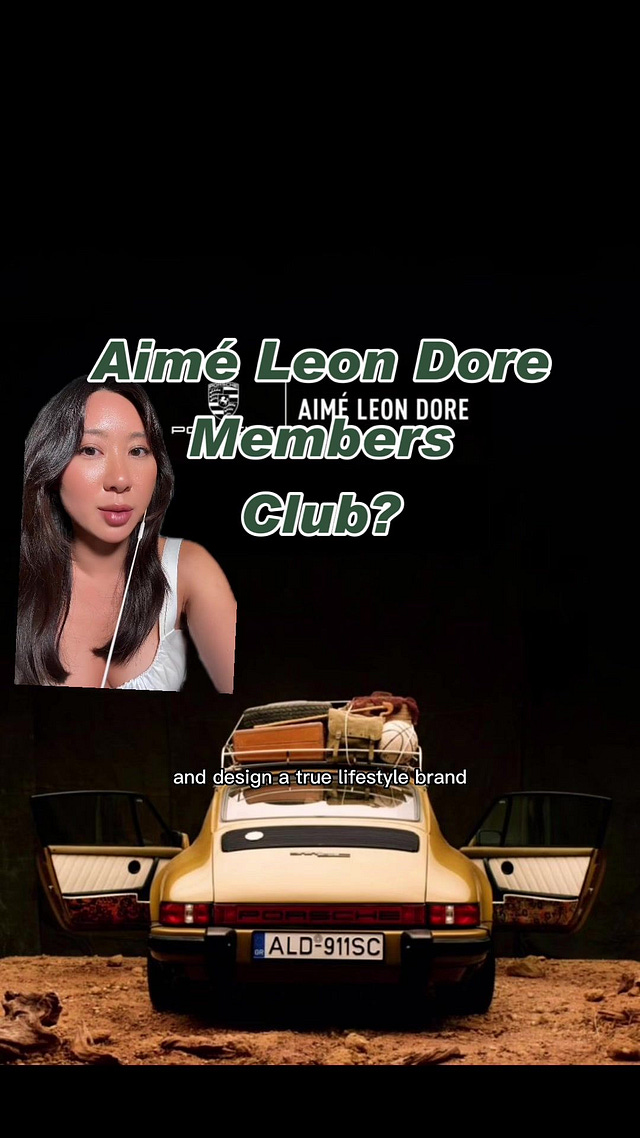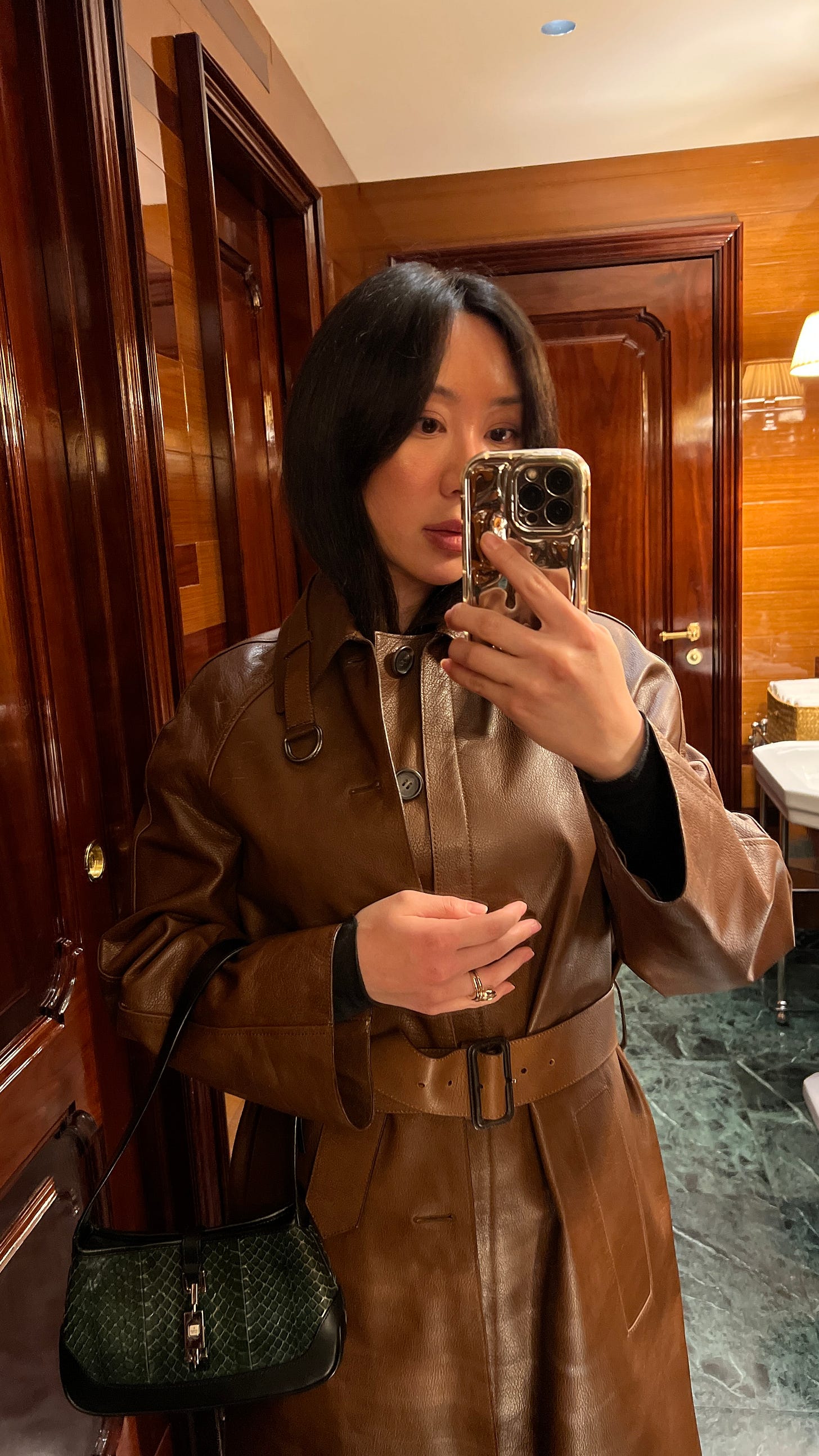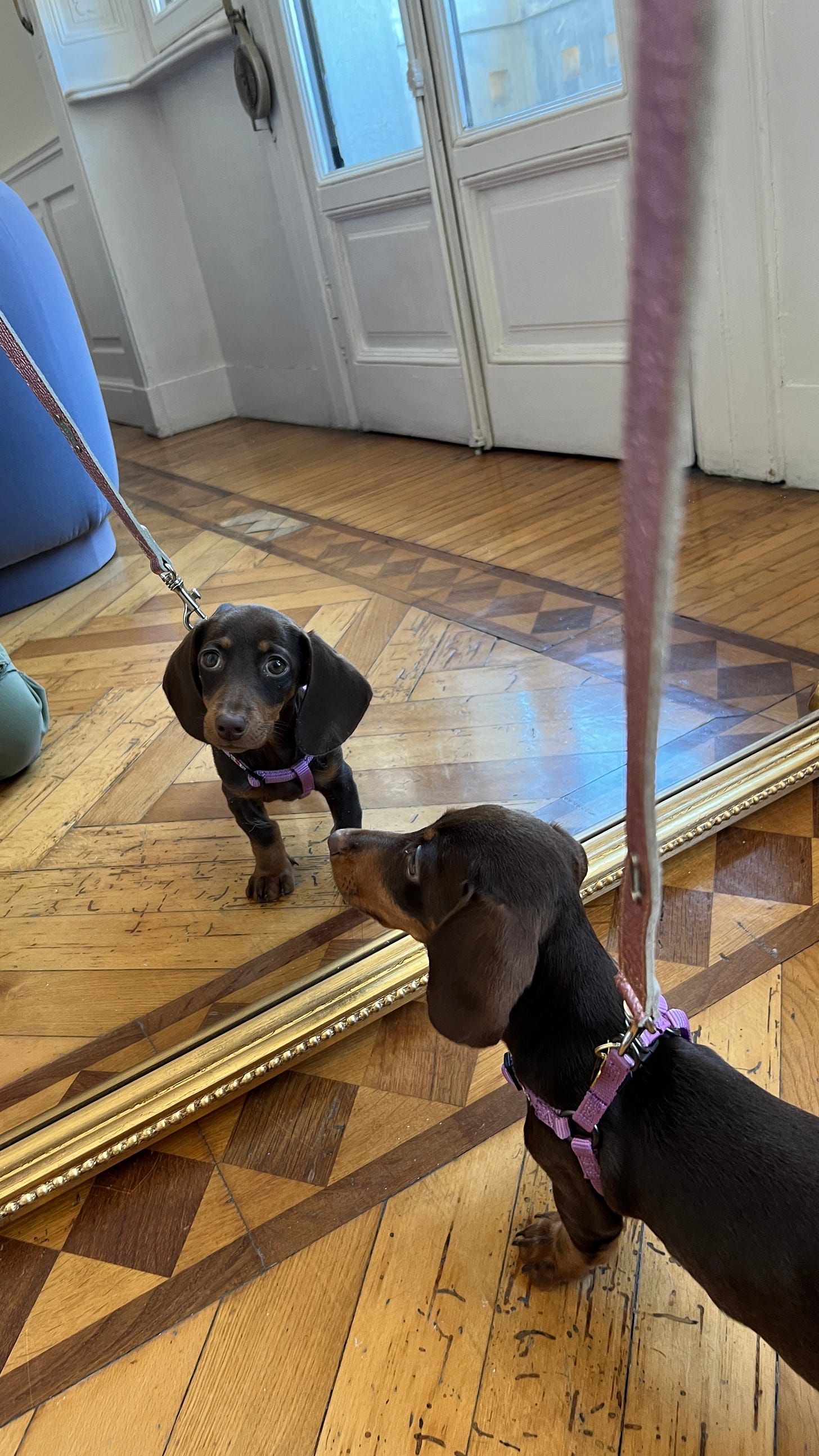Screen tests: meet Nadine Choe of The Stanza
"I realised there’s a gap in the market for content that talks about lifestyle brands from an institutional perspective."
This is a read for anyone actually wanting to get it done. For those who want to build an audience, create a great pitch deck, start a business, refine their brand, and so much more.
Meet Nadine Choe, who knows her way around structuring financing for Aman properties, carved out a (large-ish) niche of luxury hospitality meets fashion with her considered takes on brand and financing with an expertise on member’s clubs.
From making the most of a viral video to re-angling her focus on talking about the business of rather than personal, she’s one of the smartest girls in the room. And, I’d definitely want her to be reviewing my pitch deck. (For an opportunity on how to get her advice, read her newsletter,
.)It may be cliched to say that this American-now-living-in-Milan is one-to-watch; I truly feel privileged to be able to discuss with her business models and branding challenges in her industries of expertise. We jettison from speaking about Aman to Gucci, to living in Milan, to what makes a compelling content creator and how that actually teaches you the art of marketing. It is a long interview, so please do click on the ‘view full email’ option where you can.
We all can learn a lot from her.
I hope you enjoy meeting Nadine.
Tell me about yourself.
I’m currently based in Milan with my Italian husband. Before I moved to Europe, I was working in real estate private equity and development for nearly a decade, most recently at Cain International structuring the financing for the Aman Beverly Hills project.
About a year and a half ago I posted a TikTok about Aime Leon Dore, a New York streetwear brand, and how they could open a members club as a way to create loyalty and another revenue stream as part of a 360 lifestyle brand. That video went viral, but in the way that it reached a lot of people that I didn’t expect, such as industry people, real estate developers, hoteliers and fashion executives. Overnight it made me realise that I could reach that kind of audience through video content on social media, which I hadn’t previously thought was possible. I’d thought of TikTok as for someone of a younger demographic, but a lot of these people reaching out from the video were 40s, 50s, and now I have people in my 60s who read my newsletter. I realised there’s a gap in the market for content that talks about lifestyle brands from an institutional perspective.
My last employer, Cain International, finances a lot of lifestyle real estate projects, such as Aman hotels or Soho House in Rome. As a result, I would get all the pitch decks for members clubs such as San Vincente Bungalows or Soho House, and therefore I’ve underwritten most clubs that you’ve heard of in the past few years. When I posted my first video about the business of members clubs, there was no one else on social media creating similar content. And through that I started my newsletter, The Stanza Media. I’m building a community of people who are either hospitality nerds or entrepreneurs, or even fashion people who want to figure out how to incorporate hospitality into their business model because those two worlds are converging.
To a lay person, how would you explain what your previous job at Cain International was?
Every construction project needs capital. Let’s take the Aman Beverly Hills — it’s a 17-acre lot on Wilshire and Santa Monica, which is at the intersection of two main roads in Los Angeles. It’s a $5 billion budget to develop that whole site, so there are certain types of capital that would be appropriate for a project of this scale and of this risk profile. On the other risk spectrum, building a typical apartment building in New York is way less risky because you know you’ll fill that apartment more easily, and therefore how you structure the construction capital will be different. My job was to think about how financing is structured in terms of what type of returns these investors would be looking at, and it was basically a lot of number crunching.
How do people react when you tell them what you do?
People are really curious. I’m always so flattered whenever I meet someone and they say they subscribe to my newsletter, and they didn’t realise it was me. They show me my newsletter on their phone. It happens surprisingly often.
What’s the most frequently asked question you get?
How to build a community online, or an audience. There’s only one way — there’s no short-cut. It’s posting everyday, or often enough to build authority and trust with your audience while observing how people react to your voice.
Is that what you really did?
For the first six months, I posted an analysis video every single day. I figured you have to just put yourself out there. I threw everything at the wall to see what sticks and that’s when that one video went viral.
Have you done something where you thought it would do really well, but it didn’t go as planned?
In the early days I rolled out a feature where I would share people’s pitch decks to see if anyone from my audience would want to invest. The problem with that is that it’s hard to connect investors with startups without a personal introduction. People want to be vetted on both sides, they want to know who’s investing and what value they can bring to the table besides money. I realised it’s hard to do that at scale.
However, I recently iterated it into a new column called Investment Committee in which I do a full deep dive into their pitch deck and give them feedback from an investor’s perspective so that it’s actually more helpful to them. One thing that has come out from my content is that I get a lot of pitch deck submissions, and so I now give feedback for paid subscribers. Operators find that it’s really useful because if you’re so in the weeds, you can’t see your business from a zoomed out perspective. When I announced the launch of Investment Committee, I had 20 pitch decks from that one Google submission link in the first week. There was a member’s club in a tertiary city in the US where there’s no member’s club and therefore no competition with an interesting business model, a new hotel brand in Italy, another submission pitching a fashion tech platform…. There’s a lot of people doing cool things in my niche.
What’s your plan for The Stanza? Is there a plan?
I have a plan. It’s a big plan. It’s very ambitious.
Tell me about yourself without mentioning your job.
I have a little dachshund and her name is Miuccia. We got her in September so she’s quite young. Let’s just say she’s a very Milanese dog living in my Milanese apartment. She’s very sassy and sweet, but has a lot of attitude.
Why did you decide to move to Milan?
I’ve moved around a lot. I grew up in LA, I went to boarding school on the east coast. Then I went to London for uni at King’s College. Then I lived in New York for four years for work, then back to LA working for Cain, and I met my husband in Ibiza. I go there every year, it’s my favourite place. He was in London at the time and I was in LA, and I didn’t think we were going to see each other again. But then our paths brought us together and we moved to Milan from London because his family are all here in Milan. Milan has a great lifestyle advantage in terms of quality of life; the Alps are two hours away, Ibiza is two hours away.
Milan is having a moment.
Yeah – the reason why a lot of people are moving here from London is because of the tax break. The Italians are great at maintaining relevance through fashion and design, though I do think that Paris is by far the best for creativity. The way I describe it is that Italians are focused on craftsmanship and perfecting a technique over a hundred years. Whereas, the Parisians can create a fantasy world and are good at selling dreams; they’re very good at marketing.
Milan is quite commercial, it’s the finance capital of Italy.
Yeah, it’s less of a tourist city, it might not be the most preferred place to visit but it’s great to live.
How’s your Italian?
I’m learning. It’s not easy. It’s a very nuanced language. To put it in a fashion context, the last Gucci campaign, Ancora, the red – ‘ancora’ actually has several different translations in English. It could be ‘again’, ‘still’, or ‘yet’.
That’s quite beautiful.
It is. But it’s hard to translate directly. In Italian when you say ‘ancora’ it has a certain meaning.
What are you reading, watching or listening to at the moment?
I’m a huge podcast person. Podcasts are the greatest life hack - for anything you want to learn more about, you have the world’s experts literally at your fingertips.
AB Talks, I think he’s based in Abu Dhabi. He interviewed Mike Amiri who is the founder of Amiri about building a designer fashion brand.
Diary of a CEO I’m obsessed with.
What’s Contemporary Now is another good one about the creative industries
Fashion Neurosis with Bella Freud. The one with Stefano Pilati was so good. He talks about his childhood and trauma and I love learning about how we’re programmed as adults are a result of all our conditioning as children.
I love getting into the heads of these people. It makes sense when you hear someone’s real raw story why they’re so driven and ambitious.
You seem like a driven person. How did you come to be that way?
I’m the eldest daughter of immigrants. My brother now lives in Korea, but we both grew up in LA. My parents came to the US when they were around 16, and they instilled in us values of consistency, discipline and hard work, and that if you want results, you have to work hard for it. My parents were very strict on me and now I’m glad they were.
What do they think about what you do now?
My mum loves Italy so she visits often. They’re excited I’m here but it’s so far and there’s no direct flight.
Where would you tell someone to go in Milan?
Casa Cipriani. I did a staycation there recently and I was so impressed how they go out of their way to make your stay amazing. Portrait Hotel is nearby and it’s very chic. There’s several cool restaurants and bars on the ground floor of that hotel and a beautiful courtyard.
There are also many design apartments in Milan, so I would recommend staying in Brera which is a very chic, cute design district and it’s very central. As to where to eat, there are many great spots, but you cannot miss going to a traditional Milanese pastry bar. It’s a very Milanese tradition to have a coffee standing at the bar and small pastry for breakfast. It’s a weird concept for Americans who want eggs and avocado. Pasticceria Gattullo or Pasticceria Sissi are my favorites. For street style people watching, go to Bar Paradiso in Porta Romana. They have a great natural wine selection and it’s a local spot for the creative industries.
For shopping, Cavalli e Nastri. I got a great Prada brown leather trench there. It’s expensive but the trick is you can negotiate everything in Italy. Discount in Italian is ‘sconto’. So just ask for ‘un sconto’ — it’s a very reasonable thing to ask.
You get asked a lot of questions about people’s businesses or platforms. What do you want to be asked more about?
I think people should be asking more, ‘How can I be original?’ And, ‘How can I be pushing boundaries?’ Everyone right now is doing the same thing, and everyone’s referencing a little too much of the same thing whether it’s fashion or hospitality, there’s nothing really new that’s original and groundbreaking. And it’s unfortunate because people don’t realise that the best brands that start trends are that way because they are doing something that no one else wants to do. They’re taking real risks. In hospitality, for example, most new entrants over-reference Aman or Soho House. Same with fashion — too many copycats.
With the challenged economy, people are looking at historical data to make choices, so if the past says they’re selling lots of pink dresses or lip glosses, they’re going to make more of it in the future. How do you break that cycle?
The first thing for me would be a topdown approach by taking a daily problem or pain point experienced by the consumer and trying to solve for that. Currently we’re going through a creative drought, and a lot of that is driven by us being so attached to our phones and algorithms and feeding us more of the same. Honestly the best way to break out of it is to take a real break from social media and any sort of consumption pattern with the internet.
I was in New York recently and a lot of people were wearing the same thing: Toteme, The Row. I love and appreciate those brands, I buy from them, but at the same time, they’re not innovating. What’s next? That’s what everyone’s trying to figure out. I think it’s going to be something like emotional storytelling through clothes because people want to be transported. That’s why there’s so much attention on creative directors right now, because people have always seen fashion as a way to be transported into a fantasy world.
You talk a lot about exclusivity. But there’s that line between having something that’s so exclusive that’s about limiting access, but, how do you make money off it other than charging very high prices? You can increase the amount of consumers to increase sales but then you lose exclusivity.
The below is for paid readers only. She drops an incredible amount of interesting information — about where fashion business is going, the business of luxury and exclusivity and the business models, and why and when you need the emotional storytelling pull when it comes to brand marketing — and so much more.
It’s well worth a read — and I promise I’m not being biased.











